History
 Not everyone who belongs in a family history is a family member. It seems fitting to me to talk about the Hoover family, because they played a rather large part in our family’s history, and therefore were as close as family. In her young years, my great aunt, Bertha Matilda Spencer and her mother did not get along. The situation continued to be a problem for some time, and at some point it became intolerable.
Not everyone who belongs in a family history is a family member. It seems fitting to me to talk about the Hoover family, because they played a rather large part in our family’s history, and therefore were as close as family. In her young years, my great aunt, Bertha Matilda Spencer and her mother did not get along. The situation continued to be a problem for some time, and at some point it became intolerable.
I don’t know how old Bertha was when she went to live with the Hoover family, or if it was her decision or her mother’s, but she never lived at home again. Many people might think that hers was a horribly sad and lonely life after that, but to me she looked genuinely happy. That makes me think that possibly her move to the Hoover home was something that was by mutual agreement, between her and her mom, but I still have to wonder if the whole situation made my great great grandfather rather sad. I don’t know about Great Great 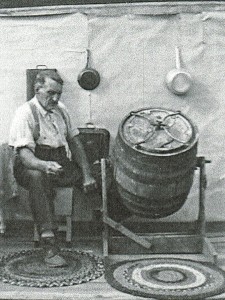 Grandma, but the rest of the family, it seems, was very close to the Hoovers…leading me to think that they missed their sister very much. Because the Hoover family was so close to his, my grandfather remained friends with them for the rest of his life, even having his picture taken with two of the Hoover boys, Ed and Joe, two years before his death.
Grandma, but the rest of the family, it seems, was very close to the Hoovers…leading me to think that they missed their sister very much. Because the Hoover family was so close to his, my grandfather remained friends with them for the rest of his life, even having his picture taken with two of the Hoover boys, Ed and Joe, two years before his death.
Mr Hoover’s name was France, and while he was a farmer by trade, he also had the ability to repair and maybe even make shoes for his family. I suppose a lot of families learned trades to help save their families money, but shoemaking is something that seems such a strange hobby these days. Of course, for France Hoover, it was not a hobby, it was a necessity. His family needed shoes, and to purchase them was expensive. I found these pictures to be very interesting, as I thought about how the shoes were made or repaired in those days. They were all hand crafted, unlike the shoes of today that are mass produced by machines. The shoes were made out of leather, while most shoes today are made out of synthetic materials. I have a feeling those shoes lasted much longer than our shoes today do too.
Shoes then were not designed for looks so much, but rather they were made in a 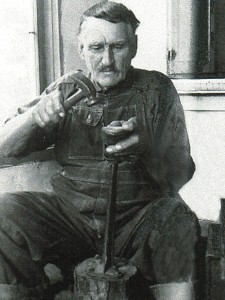 practical fashion, which would have saddened me, because I love my high heels, and I love different designs and colors. Shoes of yesteryear were quite different, and I’m sure the shoemakers would have thought of me as being half crazy. Maybe I am, but I would be in good company, I think, because there are a whole bunch of us high heel fanatics in this world. These are just different times than those were, and since they most likely had just one pair of shoes, compared to my 50 or more, theirs had to be built to last. While France Hoover was not related to me, I still find him to be an interesting character from the past. Some things he did the old fashioned way, like making and repairing shoes, and some things like cars and tractors, he had to have the latest innovations available. I suppose it just depends on where your priorities are, really, and I’m quite certain that mine are vastly different than France Hoover’s were.
practical fashion, which would have saddened me, because I love my high heels, and I love different designs and colors. Shoes of yesteryear were quite different, and I’m sure the shoemakers would have thought of me as being half crazy. Maybe I am, but I would be in good company, I think, because there are a whole bunch of us high heel fanatics in this world. These are just different times than those were, and since they most likely had just one pair of shoes, compared to my 50 or more, theirs had to be built to last. While France Hoover was not related to me, I still find him to be an interesting character from the past. Some things he did the old fashioned way, like making and repairing shoes, and some things like cars and tractors, he had to have the latest innovations available. I suppose it just depends on where your priorities are, really, and I’m quite certain that mine are vastly different than France Hoover’s were.
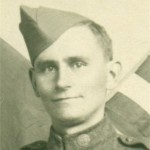
 Every soldier who ever signed up had to go through a few moments of fear or worry about where the steps they were taking were going to lead them. Whether they signed up voluntarily, or were drafted, there was always the possibility, or in many cases, the probability that they would soon find themselves fighting and killing men, or boys really, who were the same age or even younger than they were. In early wars, the fighting was hand to hand, and even when guns were invented, they often saw the result of their direct hit on the enemy. They witnessed the fear, so vividly evident on the face of that person who was the enemy, and yet was really no different than they were. Both men were scared. It truly was kill or be killed, because it was war, and the only objective was to win.
Every soldier who ever signed up had to go through a few moments of fear or worry about where the steps they were taking were going to lead them. Whether they signed up voluntarily, or were drafted, there was always the possibility, or in many cases, the probability that they would soon find themselves fighting and killing men, or boys really, who were the same age or even younger than they were. In early wars, the fighting was hand to hand, and even when guns were invented, they often saw the result of their direct hit on the enemy. They witnessed the fear, so vividly evident on the face of that person who was the enemy, and yet was really no different than they were. Both men were scared. It truly was kill or be killed, because it was war, and the only objective was to win.
Many of my ancestors have been in wars, including most recently, my dad, brothers-in-law, several uncles, nephews, and grandfathers. I have read some of my dad’s letters home from the war, and while he tried to sound positive and unafraid, you could still see, if you read between the lines, that war and a degree of fear simply went together. Still, I can imagine that as each of those men and women are standing in line to get the many vaccinations they had to have, that for a least a moment, they wondered just what they had gotten themselves into. Of course, there was really no way out. It didn’t matter if they enlisted voluntarily or were drafted, they belonged to Uncle Sam either way. They were going into battle, and that’s all there is too it.
Of course, the soldier is trained to be brave and not to show fear, and maybe they truly have to do that. I know that if you show fear to a dog, they pick up on that…so does the enemy too…maybe. All I know is that deep in their hearts, they must feel like they would like to run in the face of enemy fire. Of course, they can’t. They must fight. This is war…this is kill or be killed…this is their duty, and even if it means that they lose their life, they must do their duty. People are depending on them. Not just their platoon members, but their nation, and the people of the nation they are trying to protect from whatever evil people are trying to take them over.
When I think of our soldiers, I have to think of how very brave and courageous they are, 
 because as the saying goes, “I learned that courage was not the absence of fear, but the triumph over it. The brave man is not he who does not feel afraid, but he who conquers that fear.” I feel very proud of all those men and women in our family, as well as our friends, who have answered the call to duty, set aside their fears, and gone out to do their duty in the fight against evil. They are a huge part of what makes this country great.
because as the saying goes, “I learned that courage was not the absence of fear, but the triumph over it. The brave man is not he who does not feel afraid, but he who conquers that fear.” I feel very proud of all those men and women in our family, as well as our friends, who have answered the call to duty, set aside their fears, and gone out to do their duty in the fight against evil. They are a huge part of what makes this country great.
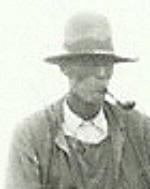 When I think about our organized military system, both during the years of the draft and now with our military being voluntary service, it occurs to me just how fortunate we, as a people, are to live where we do. There are so any evil leaders in countries who are not only enemies to the rest of the world, but in reality, enemies to their own people. In those countries, the military forces are not only not voluntary and not draft either, but rather they are forced into service, and often taken forcibly from their homes in the middle of the night, never to be seen again. Those taken are often children…even very young children, who are taken from their families and trained to be soldiers, or rather, trained killers. Their lives are viewed as unimportant. They are simply there to do the bidding of their evil government, and die doing it if necessary. They are expendable, because to replace them, the government simply goes out in the middle of the night and takes another child from another family by force. This was the position my great great grandfather, Stephan Beier found himself, his wife, Anna Maria Meier Beier, and their family in, one night in Russia. It was the reason that his family left Russia, and it was the reason my grandfather, Cornealius Byer was in the United States when he met my great great grandmother, Edna Fishburn in the Dakota Territory in the mid 1880’s.
When I think about our organized military system, both during the years of the draft and now with our military being voluntary service, it occurs to me just how fortunate we, as a people, are to live where we do. There are so any evil leaders in countries who are not only enemies to the rest of the world, but in reality, enemies to their own people. In those countries, the military forces are not only not voluntary and not draft either, but rather they are forced into service, and often taken forcibly from their homes in the middle of the night, never to be seen again. Those taken are often children…even very young children, who are taken from their families and trained to be soldiers, or rather, trained killers. Their lives are viewed as unimportant. They are simply there to do the bidding of their evil government, and die doing it if necessary. They are expendable, because to replace them, the government simply goes out in the middle of the night and takes another child from another family by force. This was the position my great great grandfather, Stephan Beier found himself, his wife, Anna Maria Meier Beier, and their family in, one night in Russia. It was the reason that his family left Russia, and it was the reason my grandfather, Cornealius Byer was in the United States when he met my great great grandmother, Edna Fishburn in the Dakota Territory in the mid 1880’s.
The family had been asleep and suddenly, they were awakened to the most horrifying event any family could ever imagine. Their son was taken at gun point, by soldiers. It was the Russian draft of the day. They did not care what his age was, nor did they care about any other qualifications, or the lack thereof. They needed more soldiers, and he had been chosen. I’m sure they had watched him for some time, along with watching many other young men his age. I don’t know how old he was at the time, but I do know that he was probably not out of school yet. What I do know is that my great great grandparents never saw their son again. My guess is that he probably lost his life in a battle somewhere within a year. The Russian leaders did not care about the soldiers…they were expendable…a dime a dozen, so their safety was unimportant. They were most likely sent into the worst battle zones, to fight the most likely to be lost battles. In that way, they government could keep their best officers and soldiers, the ones who had chosen to be there…if that was possible, safer from the worst battles. Or maybe, they put all the soldiers in the same harm’s way.
My great great grandparents were very distraught at the events of that night and they knew that they were not going to go through it again. The decision was made to secretly make their way out of Russia and go to the United States where their children could grow up safely, and if they were drafted into military service, they would be treated with dignity, and they would be able to stay in touch with their families. No parent is completely comfortable with their child going into military service, because if there is a war, their child will be in the middle of it. Nevertheless, they are proud of their child’s service…when it is done in the right way. To come into their home in the middle of the night, and forcibly take their child, knowing that they will never hear from that child again, is simply and horribly wrong. My great great grandparents decided that they were never going to go through it again. That is what made their decision to immigrate to the United States a move that was much less scary that the thought of staying in Russia. They never knew what happened to their son, and I’m certain that was something that stayed with them all their lives, but they knew they had done the right thing when they saw the rest of their family grow up and lead good lives in the United States.
 Bob and I went to the Wyoming Cavalry indoor football game last night, and there are media events at different times in the game, with things like a three person in one triple bag sack race, and kids on a bouncy ball. They asked the fans if these things took them back a few years, and that started me thinking about the things I did as a kid. One thing that came to mind was the skateboard. It was my generation who had the privilege of riding the skateboard first, and while we were first, we certainly didn’t take that ride to the skill level of the subsequent generations. I was thrilled when I could stand on the thing and ride. The thought of taking it on a railing, or up a ramp, or flipping it in the air and landing back on it, never crossed my mind…or the minds of the rest of my generation for that matter.
Bob and I went to the Wyoming Cavalry indoor football game last night, and there are media events at different times in the game, with things like a three person in one triple bag sack race, and kids on a bouncy ball. They asked the fans if these things took them back a few years, and that started me thinking about the things I did as a kid. One thing that came to mind was the skateboard. It was my generation who had the privilege of riding the skateboard first, and while we were first, we certainly didn’t take that ride to the skill level of the subsequent generations. I was thrilled when I could stand on the thing and ride. The thought of taking it on a railing, or up a ramp, or flipping it in the air and landing back on it, never crossed my mind…or the minds of the rest of my generation for that matter.
Nevertheless, at some point in time, some kid who thought that the old style tame  skateboarding was way too tame for them, decided to step it up a bit, and something new and exciting was created from a fad that probably would have died a miserably quick death otherwise. Soon the kids were doing all kinds of tricks, and spending hours each day trying to perfect something that would let them outshine their friends. Of course, there were the normal, and not so normal injuries that went along with such endeavors, but that didn’t stop the kids from working hard to create the next big thing on a skateboard. They flew along curbs and railings, flipped their boards several times in the air and managed to land right back on the board. They held competitions…just for fun, at first, but these days they compete for money, titles, trophies. Every skateboarder wants to be dubbed the King of Skateboarding. They even came out with video games on skateboarding, which my grandsons absolutely loved.
skateboarding was way too tame for them, decided to step it up a bit, and something new and exciting was created from a fad that probably would have died a miserably quick death otherwise. Soon the kids were doing all kinds of tricks, and spending hours each day trying to perfect something that would let them outshine their friends. Of course, there were the normal, and not so normal injuries that went along with such endeavors, but that didn’t stop the kids from working hard to create the next big thing on a skateboard. They flew along curbs and railings, flipped their boards several times in the air and managed to land right back on the board. They held competitions…just for fun, at first, but these days they compete for money, titles, trophies. Every skateboarder wants to be dubbed the King of Skateboarding. They even came out with video games on skateboarding, which my grandsons absolutely loved.
Even the boards have changed from the clunky ones we had when I was a kid, that were  really just skates with a board attached, and had very little maneuverability, to one that had just one wheel on each end, and twisted in the middle, to the long board that my grandsons liked, which probably mimics a surf board without the water, to many more that I have no clue about, much less how they work. I suppose that as long as we have kids who are willing to push the envelope in the world of skateboarding, we will have manufacturers who will make the designs they need to accomplish their unique skill set, thereby continuing to take skateboarding to the next level and beyond. While I enjoy watching the amazing tricks these people can perform, I think I will just stay on my own two feet, because at least that way, I won’t kill myself.
really just skates with a board attached, and had very little maneuverability, to one that had just one wheel on each end, and twisted in the middle, to the long board that my grandsons liked, which probably mimics a surf board without the water, to many more that I have no clue about, much less how they work. I suppose that as long as we have kids who are willing to push the envelope in the world of skateboarding, we will have manufacturers who will make the designs they need to accomplish their unique skill set, thereby continuing to take skateboarding to the next level and beyond. While I enjoy watching the amazing tricks these people can perform, I think I will just stay on my own two feet, because at least that way, I won’t kill myself.
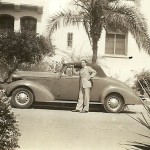 When my dad was a young man, he decided to leave the cold climate of Wisconsin, and move to sunny California to start a new life. He went to work for Douglas Aircraft, and he did very well there. He probably would have stayed there had World War II not intervened. I sometimes wonder how his life might have been different had he stayed there, or had he gone back there after the war. Would he have met my mom, and if so, would we have all lived in California. I can’t say that I am sorry that his life took the path that it did, because it made him the man who became my dad. His path shaped who he was and who we all became, and that is just fine with me. I don’t think I would have wanted to be anywhere else really, even though I sometimes wish I lived somewhere warm.
When my dad was a young man, he decided to leave the cold climate of Wisconsin, and move to sunny California to start a new life. He went to work for Douglas Aircraft, and he did very well there. He probably would have stayed there had World War II not intervened. I sometimes wonder how his life might have been different had he stayed there, or had he gone back there after the war. Would he have met my mom, and if so, would we have all lived in California. I can’t say that I am sorry that his life took the path that it did, because it made him the man who became my dad. His path shaped who he was and who we all became, and that is just fine with me. I don’t think I would have wanted to be anywhere else really, even though I sometimes wish I lived somewhere warm.
Nevertheless, as I look at some of the pictures of him at that time, a thought forms in my mind. My dad looks like a Hollywood Producer…or at least what I picture a Hollywood Producer looking like at that time in history. He is standing next to a modern automobile…at least it was then, and wearing a nice suit…much like I would expect a Hollywood Producer of that era to be wearing. I don’t know what event my dad was going to, or if he was just dressed up so he could get a good picture to show off his car, but I do know that he looked real classy. As I have looked through the old pictures my dad had, the pictures from California were very intriguing to me. California is probably the least like my dad’s personality of any state in the United States. He always liked the mountains and the rural areas of the country. That is something I agree with. I love the mountains, and I don’t like congested areas. So, what had drawn him to California?
It is rather strange for me to think of my dad living in California. It seems so out of character  for him, except for the ocean and the Redwoods, both of which he always loved. Other than that, he never was the California type. Nevertheless, California might have been very different then, but I just don’t think it fit his personality. Still, he was a young man then, and I’m sure he was trying out new things, to see who he was and where he wanted to be. Nevertheless, I can’t imagine my dad doing anything but the work he did. During the years he was growing up, he and his brother liked to build things, so mechanical things were more their style, and that along with the welding he learned back then, were his life’s work. He definitely isn’t a Hollywood Producer type, but as they say, “He sure did clean up nice!”
for him, except for the ocean and the Redwoods, both of which he always loved. Other than that, he never was the California type. Nevertheless, California might have been very different then, but I just don’t think it fit his personality. Still, he was a young man then, and I’m sure he was trying out new things, to see who he was and where he wanted to be. Nevertheless, I can’t imagine my dad doing anything but the work he did. During the years he was growing up, he and his brother liked to build things, so mechanical things were more their style, and that along with the welding he learned back then, were his life’s work. He definitely isn’t a Hollywood Producer type, but as they say, “He sure did clean up nice!”
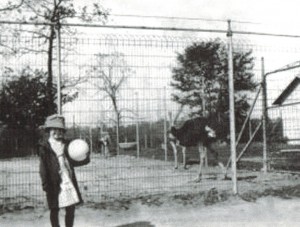 Most kids love to go to the zoo, and it is a special treat if they have to go to some other town to go, such as visiting relatives. I don’t recall going to the zoo as a kid, but I’m sure we must have. I remember taking my girls to the zoo in Denver, and they loved it. These days the zoo usually even includes the aquatic area. You can go and spend the whole day there.
Most kids love to go to the zoo, and it is a special treat if they have to go to some other town to go, such as visiting relatives. I don’t recall going to the zoo as a kid, but I’m sure we must have. I remember taking my girls to the zoo in Denver, and they loved it. These days the zoo usually even includes the aquatic area. You can go and spend the whole day there.
Back when my Aunt Laura was a little girl, the zoo was very different than it is now, but the draw was the same. When a child can find themselves so close to wild animals, it is as much a rush as it is for adults. For Aunt Laura, this was a red letter day. I think it was for my grandmother as well, because she wanted pictures to remember the event. I have to wonder what a zoo looked like back then…was it primitive, with just fenced areas around the animals’ habitats, or was that just what the particular area they were at when the picture was taken. My guess is that no matter what it looked like, my Aunt Laura was beside herself with excitement to be going. I know that is how I would have felt at her age. I can imagine how wonderful the day was for a little girl. Strolling along in the sunshine with her mom, looking at all the different animals. It must have been almost like a class field trip for her, except that she was not in 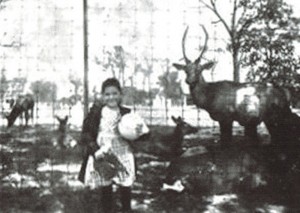 school.
school.
These days, the zoo is pretty much a common thing. Most people have been to one at some time in their lives. But back then, not so much. For my Aunt Laura, it was a day she would always remember, and I think it felt that way for her mother too. It appears to have been a ladies day out with family, and that probably made it even more special. Nevertheless, the most special thing to any kid is going to be the animals. There is always time to be excited about being with relatives, after all. But the Zoo…well, that’s the coolest thing ever!!
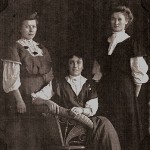 For some time now, I have been trying to find any information on the family of my Great Grandma Henriette Hensel Schumacher. The pictures we have of Grandma’s immediate family, which includes my grandmother, Anna Schumacher Spencer, always seem to include two cousins. We know that their names are Anna Schubring and Laura Kurth. We don’t know if those are maiden names or married names, and that makes this harder. Recently, I found a picture of a family, and I believe that the oldest girl is Laura Kurth. The other girls did not exactly look like Anna Schubring, but I thought that possibly this family was my great grandmother’s sisters family. She was the sister that my grandmother came to America with, and since her first husband died, and she remarried and had more children, That could explain the difference in the two girls features.
For some time now, I have been trying to find any information on the family of my Great Grandma Henriette Hensel Schumacher. The pictures we have of Grandma’s immediate family, which includes my grandmother, Anna Schumacher Spencer, always seem to include two cousins. We know that their names are Anna Schubring and Laura Kurth. We don’t know if those are maiden names or married names, and that makes this harder. Recently, I found a picture of a family, and I believe that the oldest girl is Laura Kurth. The other girls did not exactly look like Anna Schubring, but I thought that possibly this family was my great grandmother’s sisters family. She was the sister that my grandmother came to America with, and since her first husband died, and she remarried and had more children, That could explain the difference in the two girls features.
Last night I stumbled upon a little bit more information. The girls are not sisters, or even half sisters, as I had originally thought they might be. My sister, Cheryl thought that the father in the family picture looked a bit like our Great Grandfather Carl Schumacher, and thought he could be his brother. I now believe that she is right in that. What I found is a page from my Uncle Bill’s family history, but it wasn’t with the rest of his history books…it was in some pictures he had sent to my cousin, Tracey Schumacher-Inglimo’s family. This picture tells us that Anna Schubring is the daughter of one of Great Grandma Henriette Hensel Schumacher’s sister and that she came from Canada. Anna could possibly be the daughter of the sister that my great grandmother came to America with, whose husband died a short time later, and she remarried and had more children. Having a step father could also be part of the reason that Anna spent so much time with her Aunt Henriette’s family. Sometimes the step parent situation doesn’t work out so well for some of the children. If Anna is that child, then she has a sibling that would be from that first marriage too, but we don’t really have any information on that.
Laura Kurth is also a cousin, but on the Schumacher side, so Cheryl is probably right in that she thought the father in the family picture looked like our great grandfather, Carl Schumacher’s side of the family. Cheryl also thought that Anna looked older than Laura, so she might be correct in that too. Laura’s family lived in the Mazeppa, Minnesota area, which might explain why she spent a lot of time with her Aunt Henriette and Uncle Carl’s family…not 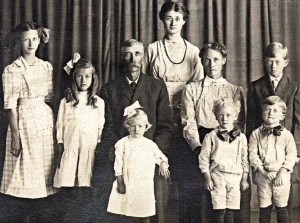 to mention that she and my grandma, Anna Schumacher Spencer were fairly close in age. I am also assuming that Kurth was Laura’s married name, and that her dad was the Schumacher brother, but I could be mistaken in that too, and it could be that her mother was the blood relation to my great grandfather. I may never find out for sure just how these cousins fit into our family, but I will most likely not stop looking until I do find out. Nevertheless, these pictures lad me to believe that my great grandparents were very close to their siblings, even if there is a sense of mystery to my family and their elusive ancestors too.
to mention that she and my grandma, Anna Schumacher Spencer were fairly close in age. I am also assuming that Kurth was Laura’s married name, and that her dad was the Schumacher brother, but I could be mistaken in that too, and it could be that her mother was the blood relation to my great grandfather. I may never find out for sure just how these cousins fit into our family, but I will most likely not stop looking until I do find out. Nevertheless, these pictures lad me to believe that my great grandparents were very close to their siblings, even if there is a sense of mystery to my family and their elusive ancestors too.
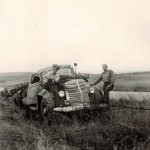 Everyone has done it…stopped, or at least slowed way down to they can look at the roadside wreck they have just come up on. Of course, we all hope and pray that the people who were involved are ok, and we feel really bad for them that their vehicle is a big mess, if not a complete total. Still, we can’t help but look at the scene with curiosity. We wonder how the accident happened, and who was at fault. And while it may seem strange, we find ourselves in awe at the way metal can twist and go from being a car to something that doesn’t even resemble a car. My dad and his brother, my Uncle Bill came up on this truck at the side of the road. It had rolled, and I guess there wasn’t a tow truck readily available, so it was left on the side of the road for a time. Well, their curiosity got the better of them, and they stopped to have their picture taken by the wreck. Maybe it was the first one they had ever seen…who knows.
Everyone has done it…stopped, or at least slowed way down to they can look at the roadside wreck they have just come up on. Of course, we all hope and pray that the people who were involved are ok, and we feel really bad for them that their vehicle is a big mess, if not a complete total. Still, we can’t help but look at the scene with curiosity. We wonder how the accident happened, and who was at fault. And while it may seem strange, we find ourselves in awe at the way metal can twist and go from being a car to something that doesn’t even resemble a car. My dad and his brother, my Uncle Bill came up on this truck at the side of the road. It had rolled, and I guess there wasn’t a tow truck readily available, so it was left on the side of the road for a time. Well, their curiosity got the better of them, and they stopped to have their picture taken by the wreck. Maybe it was the first one they had ever seen…who knows.
 I suppose that since cars were a little bit less common back then, wrecks were too. So, maybe that was a big part of the draw to look over the wreck…but that doesn’t explain the fascination we still seem to have. People take pictures of the wreck and post it to Facebook, the newspaper sends a reporter out there to get the shots that will go into the paper, and the television station sends reporters out to get shots for the news. Odd as it is, we still seem to want to see these wrecks. I suppose it is an appetite for the sensational. We watch monster truck wrecks, and love to see the rollovers. I suppose we have become somewhat immune to the reality of what these accidents can bring to pass in peoples’ lives.
I suppose that since cars were a little bit less common back then, wrecks were too. So, maybe that was a big part of the draw to look over the wreck…but that doesn’t explain the fascination we still seem to have. People take pictures of the wreck and post it to Facebook, the newspaper sends a reporter out there to get the shots that will go into the paper, and the television station sends reporters out to get shots for the news. Odd as it is, we still seem to want to see these wrecks. I suppose it is an appetite for the sensational. We watch monster truck wrecks, and love to see the rollovers. I suppose we have become somewhat immune to the reality of what these accidents can bring to pass in peoples’ lives.
As an insurance agent, I see the other side of many of these accidents. I am thankful that I very seldom see accidents with fatalities. Maybe that is just that I live in Wyoming, and with less people in our state, there is less likelihood that there will be a fatality in any given  accident. Whatever the case may be, I have been fortunate enough to only have to deal with a small amount of fatalities in the 25 years I have been an agent. Nevertheless, the accidents with injuries, especially when it is a family member, even if the injuries are very minor, can be very traumatic. Probably the worst one for me, was the accident involving my niece, Lacey when a semi-truck ran a red light, and hit her car. Thankfully, she and her cousin had only minor injuries. The truck driver felt so horrible about the accident, that he sold his truck, and quit driving trucks completely. While not all roadside wrecks are this bad looking, sometimes they don’t have to be in order to be really bad.
accident. Whatever the case may be, I have been fortunate enough to only have to deal with a small amount of fatalities in the 25 years I have been an agent. Nevertheless, the accidents with injuries, especially when it is a family member, even if the injuries are very minor, can be very traumatic. Probably the worst one for me, was the accident involving my niece, Lacey when a semi-truck ran a red light, and hit her car. Thankfully, she and her cousin had only minor injuries. The truck driver felt so horrible about the accident, that he sold his truck, and quit driving trucks completely. While not all roadside wrecks are this bad looking, sometimes they don’t have to be in order to be really bad.
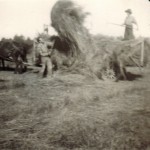 These days there are machines that can cut, bail, and stack hay with ease, but in times past, it was not so easy. There were machines that cut the hay, but then it had to be thrown up on a wagon with a pitchfork and hauled to where the haystack was going to be placed, unloaded and thrown up onto the haystack by hand using the pitchfork again. Then someone had to be up on the top leveling it out so that the ha could be stacked higher. It was no easy job, and the more people you had helping the better off you were. It was definitely not a job for one person, and definitely not for wimps. The farmer and his crew had arms of steel, because hay is not light, no matter how it looks. I have helped move hay bails, and found out for myself that it is not a job for lightweights.
These days there are machines that can cut, bail, and stack hay with ease, but in times past, it was not so easy. There were machines that cut the hay, but then it had to be thrown up on a wagon with a pitchfork and hauled to where the haystack was going to be placed, unloaded and thrown up onto the haystack by hand using the pitchfork again. Then someone had to be up on the top leveling it out so that the ha could be stacked higher. It was no easy job, and the more people you had helping the better off you were. It was definitely not a job for one person, and definitely not for wimps. The farmer and his crew had arms of steel, because hay is not light, no matter how it looks. I have helped move hay bails, and found out for myself that it is not a job for lightweights.
My dad’s family spent a lot of time making hay when they owned the farm in Minnesota, and 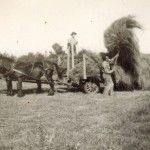 my Uncle Bill helped his wife’s family too over the years that they owned a farm. Load after load, they worked the weekend away. Moving the hay from the hayfield to the stack behind the old barn, where it would stay stacked until it was needed. It was hard work, but Uncle Bill was on his days off, and so they wanted to get as much done in the time they had before he had to go back to work in the shipyards. I haven’t had the impression that it was a job that any of them enjoyed very much, but rather it was a job that had to be done, so they did it. I think I can agree with Uncle Bill when he said that he was glad when hay making time was finally over. Now that we don’t raise cows, I can honestly say that moving hay around in any form, is something I don’t miss. I think it must have taken a very determined person to work a farm the way it had to be done back in the days when there weren’t all the machines there are these days. The work is hard enough these days, even with all the machines, so
my Uncle Bill helped his wife’s family too over the years that they owned a farm. Load after load, they worked the weekend away. Moving the hay from the hayfield to the stack behind the old barn, where it would stay stacked until it was needed. It was hard work, but Uncle Bill was on his days off, and so they wanted to get as much done in the time they had before he had to go back to work in the shipyards. I haven’t had the impression that it was a job that any of them enjoyed very much, but rather it was a job that had to be done, so they did it. I think I can agree with Uncle Bill when he said that he was glad when hay making time was finally over. Now that we don’t raise cows, I can honestly say that moving hay around in any form, is something I don’t miss. I think it must have taken a very determined person to work a farm the way it had to be done back in the days when there weren’t all the machines there are these days. The work is hard enough these days, even with all the machines, so 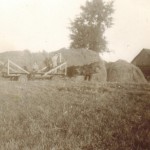 imagine what it would be like without them. No wonder those people were so strong.
imagine what it would be like without them. No wonder those people were so strong.
And after the hay was stacked, you had to use a pitch fork again to move it to where you needed it for the animals. So, now the whole process is reversed, as they haul the hay off of the stack, thereby bringing about the need to make more hay the next summer. Of course it is all necessary, and that is why farmers and ranchers do it. The hay is needed for the animals. This whole process causes me to really respect the farmer and rancher…especially the ones from days gone by because theirs was one really hard job.
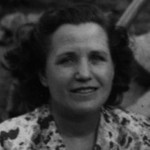 I have been reading my Great Aunt Bertie Schumacher’s journal for a while now, and every time I pick it up I find something new. She started her journal by talking about how any writer can become famous in time, simply by observing the events around them and writing about those events, how they made people feel, and what happened because of those events. As a writer myself, I began to think about what she said, because there really is a vast difference, I think, between a writer and a reporter. A reporter simply tells the events as they happened, but a writer elaborates on the events, the people involved, and their feelings. There are reporters who are writers, obviously, but I think it would be very hard for a writer not to interject their thoughts and feelings into a report.
I have been reading my Great Aunt Bertie Schumacher’s journal for a while now, and every time I pick it up I find something new. She started her journal by talking about how any writer can become famous in time, simply by observing the events around them and writing about those events, how they made people feel, and what happened because of those events. As a writer myself, I began to think about what she said, because there really is a vast difference, I think, between a writer and a reporter. A reporter simply tells the events as they happened, but a writer elaborates on the events, the people involved, and their feelings. There are reporters who are writers, obviously, but I think it would be very hard for a writer not to interject their thoughts and feelings into a report.
Aunt Bertie wanted to tell a little bit about the things that were going on in their time. Still, she could not help but put into words how she felt about the events of the day. She mentioned that the first Kindergarten was formed in 1873. At that time there were only about 200 high schools in the entire country, but by 1900 there were 6000, along with colleges that were heavily endowed by the Rockefeller, Stanford, and Vanderbilt families. Fisk College for “blacks” came into being. Women were coming to the foreground. Football became a part of college life. You could become a doctor in four months…later it took three years, and we all know it takes much longer now. At that time, 98% of children were in the grades. Aunt Bertie mentions that it was thought that education was a cure all. Authors like Emily Dickinson, Bret Hart, and Mark Twain tried to enrich the world. There were streetcar and yacht races, P.T Barnum Circus, Dwight Moody held mass revivals, and McGuffy’s Reader taught moral lessons. And then she tells about the thing that bothers her the most, when she said, “But all this did not abolish CHILD LABOR!” 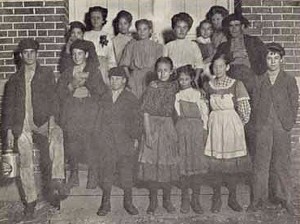 It seemed to Aunt Bertie that there were so many changes that the nation was seeing, but the one thing that appalled her the most at the time, was still there, and still endangering the lives of children. It was so hard for her to imagine that with everything else moving with such monumental steps toward a more modern civilization, that was so much more educated, that no one could stop child labor. In fact it seemed to her that no one noticed it, or even cared at all.
It seemed to Aunt Bertie that there were so many changes that the nation was seeing, but the one thing that appalled her the most at the time, was still there, and still endangering the lives of children. It was so hard for her to imagine that with everything else moving with such monumental steps toward a more modern civilization, that was so much more educated, that no one could stop child labor. In fact it seemed to her that no one noticed it, or even cared at all.
Her writings picture disasters, such as the panic in 1873, at the height of the reconstruction of the 1870’s…widespread unemployment, bankruptcy of many people, and failure of businesses, the Great Chicago fire and fires in Wisconsin, Boston, and other places that caused the failure of Insurance Companies who did not have enough Reserves to cover all of these disasters, railroad strikes and violence. Then she mentions what she terms “the sins of society”, one million people living in New York slums…ten to fifteen people in three rooms. The thought of so many people being forced to live in such appalling conditions tore at Aunt Bertie’s heart. Somehow, these things just should not be, and yet this was the world we were living in at that time.
Aunt Bertie wanted to tell about the things that were changing in our world, and how many improvements those changes were making to the world, but her tender heart just couldn’t get past the horrible injustices she could still see. There are lessons to be learned from her writings. Lessons of compassion, kindness, charity, and love for our fellow man. All too often we are so busy working on the improvements we want to make in our lives, society, and our 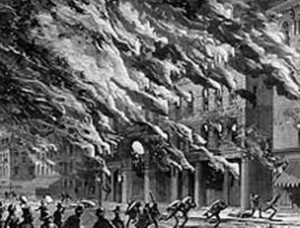 world in general, that we forget about how those things could affect the lives of others. The greed of the factory owners could not see past the profit to what their child laborers were suffering. Many changes have come from the horrors of the past. Child labor laws now protect our children, and as an insurance agent, I know that companies must hold enough in reserve to cover disastrous losses, and that while no insurance company is completely safe from failure, there is far less chance of it these days because of those reserves. While those days and events tore at Aunt Bertie’s tender heart, maybe society wasn’t totally deaf to the plight of the people after all.
world in general, that we forget about how those things could affect the lives of others. The greed of the factory owners could not see past the profit to what their child laborers were suffering. Many changes have come from the horrors of the past. Child labor laws now protect our children, and as an insurance agent, I know that companies must hold enough in reserve to cover disastrous losses, and that while no insurance company is completely safe from failure, there is far less chance of it these days because of those reserves. While those days and events tore at Aunt Bertie’s tender heart, maybe society wasn’t totally deaf to the plight of the people after all.

